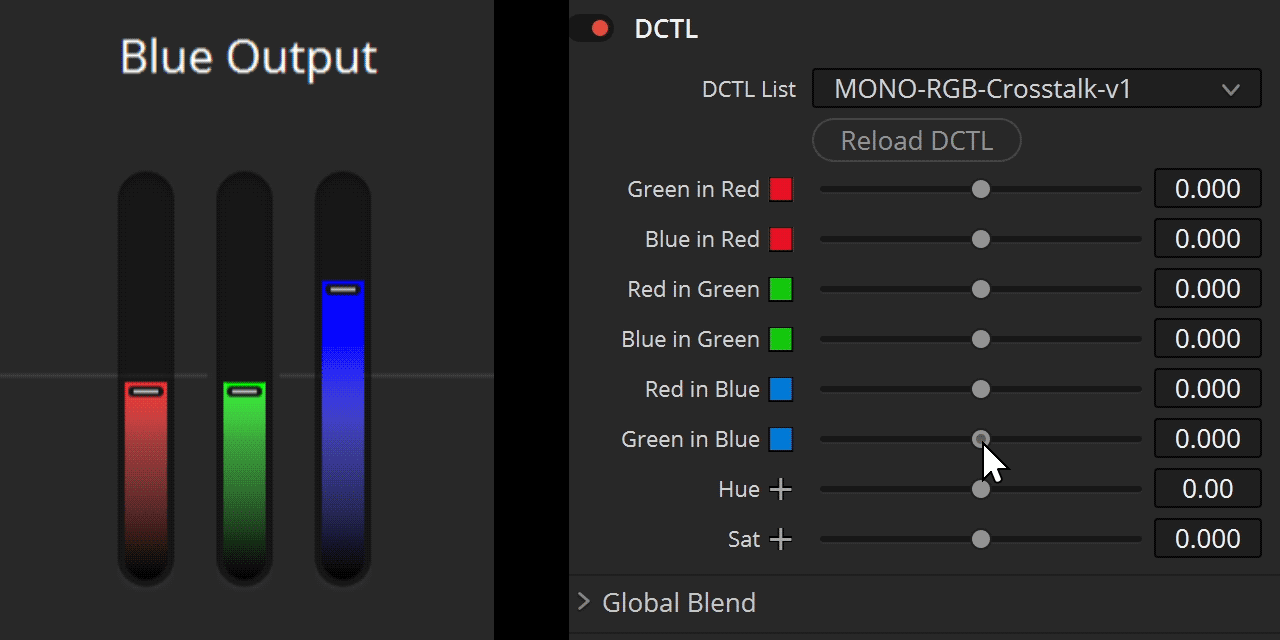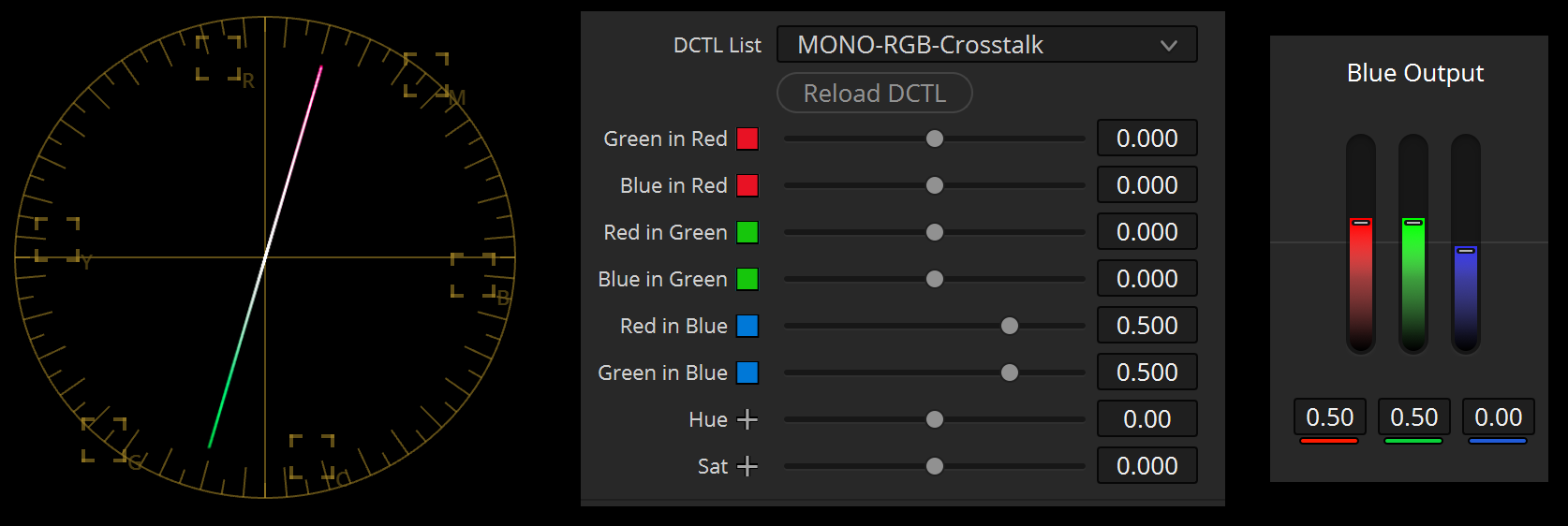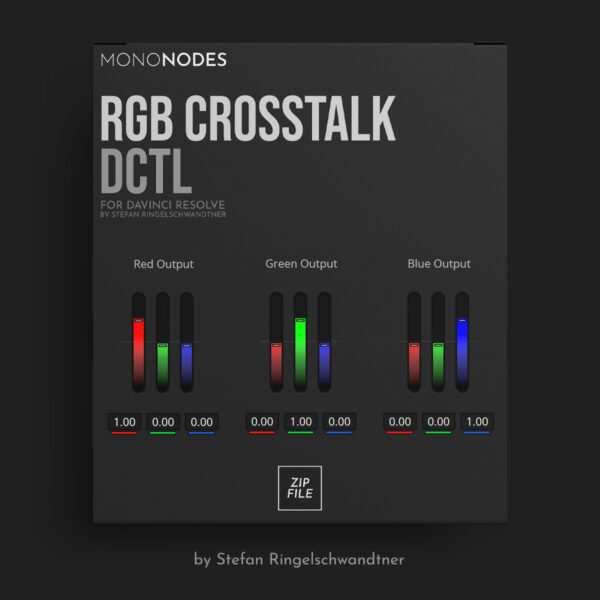RGB CROSSTALK DCTL
RGB CHANNEL MIXER

INTRODUCTION
The RGB Mixer has sliders for adjusting the contributions of Red, Green, and Blue colors to the output. Changing a slider affects the overall color value, requiring adjustment of another slider in the same color channel to restore neutral hues. This can be time-consuming.
The RGB Crosstalk DCTL simplifies this process by preserving neutral colors during channel adjustments. The design maintains a constant total color value, ensuring neutral colors remain neutral.
SUM = 1
The “RGB Crosstalk DCTL” maintains the total color value in each channel, meaning the sum of the color contributions to each output channel always equals 1, regardless of how you adjust the sliders. This feature provides precise control over the color grading process, allowing modification of color tones without disrupting the image’s overall color balance.

SOME EXAMPLES
For the “Red Output”, we have the “Green in Red” and “Blue in Red” sliders. The non-visible “Red in Red” slider will be adjusted automatically inside the DCTL, so the output always equals 1.
For the “Green Output”, we have the “Red in Green” and “Blue in Green” sliders.
For the “Blue Output”, we have the “Red in Blue” and “Green in Blue” sliders.
With the DCTL, you always just have to adjust two sliders. The third slider (not visible) will be adjusted automatically to equal 1.
– Lowering Red to -0.20
– Increasing Green to 0.50
The “Blue” slider/value
automatically goes down to 0.70.
(Not visible in the DCTL)
– Increasing Red to 0.80
The “Blue” slider/value
automatically goes down to 0.20.
(Not visible in the DCTL)
– Increasing Red to 0.50
– Increasing Green to 0.50
The “Blue” slider/value
automatically goes down to 0.00.
(Not visible in the DCTL)
– Lowering Green to -1.00
The “Blue” slider/value
automatically goes up to 2.00.
(Not visible in the DCTL)
HUE & SATURATION
When utilizing the RGB mixer functionality of this tool, adjustments can potentially shift the colors in your footage, including skin tones. Such shifts could cause skin tones to deviate from their natural hue, potentially leading to an unnatural or inconsistent appearance within the scene.
To address this, the DCTL is designed with an integrated hue rotation slider. This feature allows users to ‘rotate’ the hues in their images post RGB mixer adjustments. The rotation capability can effectively realign the skin tones back to their natural position along the skin tone line.
The “Sat” slider is working in a subtracting way. Similar to the DCTLs in my “COLOR SHIFT” pack.
VIDEO
YouTube: https://youtu.be/XCvsZ8WDKyY
Vimeo: https://vimeo.com/830901826
DOWNLOAD
FREE DEMO VERSION
ko-fi.com / 15 KB
This version includes a watermark, displayed as a grid
of black pixels on the image. The demo version is perfect
for users who want to explore the software’s features
and functionalities before making a purchase.
BUY
SYSTEM REQUIREMENTS
“RGB Crosstalk” is versatile, operating seamlessly on PC, Mac, and Linux platforms. It has been rigorously tested with NVIDIA and AMD GPUs on PCs, as well as with the M1 chip on Macs, leveraging both CUDA and OpenCL infrastructures. It’s crucial to note that DCTLs are only supported in the DaVinci Resolve Studio.
Minimum Requirement:
CPU: Intel Core i7, AMD Ryzen 7, or Apple M1
RAM: 16 GB
GPU: 4 GB VRAM
Recommended Requirement:
CPU: Intel Core i9, AMD Ryzen 9, or higher-tier Apple Silicon
RAM: 32 GB
GPU: 8 GB+ VRAM
KNOWN BUGS
Please be aware of an existing problem related to emojis causing disconnections in mini panels. In the provided package, you will also find a version labelled “NI”, which stands for “No Icons”. This variant is included to help manage potential issues with the standard DCTL. Should you experience any complications with the default DCTL, feel free to utilize the ‘NI’ version as an alternative.
Have fun.
If you have any questions / suggestions / comments, feel free
to contact me at stefanATmononodesDOTcom






